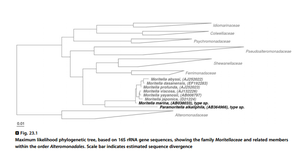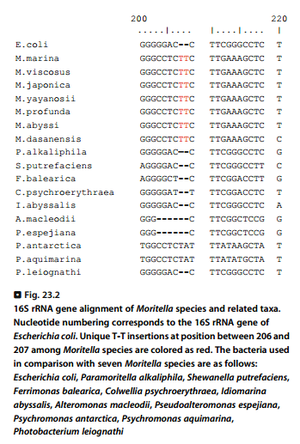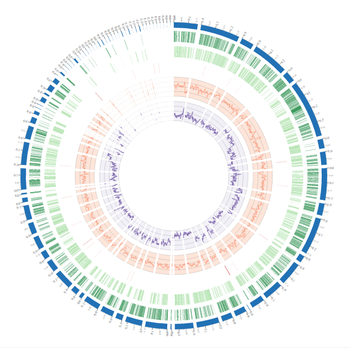Moritella marina: Difference between revisions
Cmcole1736 (talk | contribs) (→Author) |
Cmcole1736 (talk | contribs) (→Author) |
||
| Line 80: | Line 80: | ||
=Author= | =Author= | ||
Sarah Fayed and Brandon Galindo | Sarah Fayed and Brandon Galindo with Microbial Ecology Instructor Dr. Hideotoshi Urakawa | ||
Revision as of 06:03, 9 December 2016
Classification
Domain: Bacteria
Phylum: Proteobacteria
Class: Gammaproteobacteria
Order: Alteromonadales
Family: Moritellaceae
Genus: Moritella
Species
M. japonica, M. yayanosii, M. viscosa, M. profunda, M. abyssi, M. dasanesis
Description and Significance
Moritella marina is a gram-negative halophilic psychrophilic facultative anaerobe with curved or straight rods, motile polar flagella that produce PUFA’s (polyunsaturated fatty acids) and DHA (docosahexanoic acid). “Twenty-five years ago, a marine bacterium originally designated Vibrio marinus and later renamed Moritella marina MP-1 was reported to produce high levels of DHA (18% of the total fatty acids). Such high levels of DHA presumably provide this bacterium with the ability to maintain appropriate membrane fluidity in the low temperatures and high pressures of its marine environment.” “Phylogenetic tree of some representatives of the γ-subclass of the class Proteobacteria showing the position of 16S rDNA sequences from some Alteromonas macleodii-related strains and clone sequences from picoplankton DNA from the Mediterranean Sea mesocosm experiment. Sequences of clones 17B161 and 1B161 are available under accession number Y18229 and Y18231, respectively. The tree was calculated by the algorithm of De Soete [16]. The percentage of 500 bootstrap samplings that support branching points above 80% confidence are indicated. The scale bar corresponds to two nucleotide substitutions over 100 sequence positions. The tree was rooted with Roseobacter algicola as an outgroup.” (FEMS, 1998)
16S Ribosomal RNA Gene Information
“Sequence variation at positions 73–98 and 181–214 (E. coli nomenclature) within two variable regions of the 16S rDNA of representatives of clone clusters 1–5 and some strains isolated from mesocosm B. Probe target regions are in bold” (FEMS,1998)
Genome Structure
Look at Figure: 3
Ecology and pathogenesis
Moritella marina have been found in a variety of cold water marine environments, ranging from the ocean floor to the intestinal tract of marine organisms. Most Moritella species are thought to live mutualistically amongst larger marine organisms, but Moritella viscosa has been noted to cause skin ulcers in some fish (Urakawa, 2014).
Current Research
Moritella marina has been noted for having unusually high production of the long chain polyunsaturated fatty acids (PUFAs). When M. marina strain MP-1 was cultured in medium containing cerulenin, a fatty acid synthesis inhibitor, decreases in levels of middle-chain fatty acids and remarkable increases in levels of DHA were observed. These results suggest that the synthesis of middle-chain fatty acids works independently of the synthesis of DHA. M. marina was also found to produce chitonase when induced with chiton (Stefanidi, E., & Vorgias, C. E., 2008).
References
And, Kumar B. Kautharapu. "Kumar B. Kautharapu." Genome Sequence of the Psychrophilic Deep-Sea Bacterium Moritella Marina MP-1 (ATCC 15381). N.p., 2012. Web. 02 Dec. 2016. http://jb.asm.org/content/194/22/6296.full
Urakawa, H., Kita-Tsukamoto, K., Steven, S. E., Ohwada, K., & Colwell, R. R. (1998). A proposal to transfer Vibrio marinus (Russell 1891) to a new genus Moritella gen. nov. as Moritella marina comb. nov. FEMS microbiology letters, 165(2), 373-378. http://femsle.oxfordjournals.org/content/165/2/373.full#ref-13
Pukall, R., Päuker, O., Buntefuß, D., Ulrichs, G., Lebaron, P., Bernard, L., ... & Stackebrandt, E. (1999). High sequence diversity of Alteromonas macleodii-related cloned and cellular 16S rDNAs from a Mediterranean seawater mesocosm experiment. FEMS Microbiology Ecology, 28(4), 335-344.
http://femsec.oxfordjournals.org/content/28/4/335
Stefanidi, E., & Vorgias, C. E. (2008). Molecular analysis of the gene encoding a new chitinase from the marine psychrophilic bacterium Moritella marina and biochemical characterization of the recombinant enzyme. Extremophiles, 12(4), 541-552.
"FEMS Microbiology Ecology." High Sequence Diversity of Alteromonas Macleodii-related Cloned and Cellular 16S RDNAs from a Mediterranean Seawater Mesocosm Experiment | FEMS Microbiology Ecology. N.p., n.d. Web. 02 Dec. 2016.
http://femsec.oxfordjournals.org/content/28/4/335
http://www.bacterio.net/moritella.html
Genome structure image:
https://www.patricbrc.org/portal/portal/patric/CircosGenomeViewer?cType=genome&cId=1202962.4
http://jb.asm.org/content/194/22/6296.full.pdf
http://lib.dr.iastate.edu/cgi/viewcontent.cgi?article=1177&context=cbe_pubs
http://www.biochemsoctrans.org/content/28/6/943.long
http://link.springer.com/referencework/10.1007%2F978-3-642-30194-0
http://jb.asm.org/content/99/1/326.full.pdf
Author
Sarah Fayed and Brandon Galindo with Microbial Ecology Instructor Dr. Hideotoshi Urakawa



